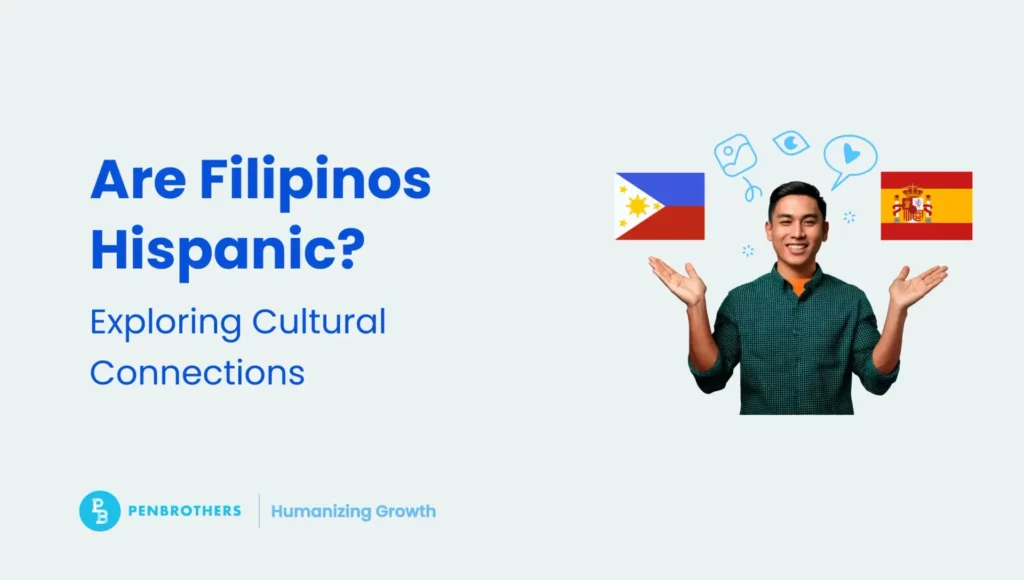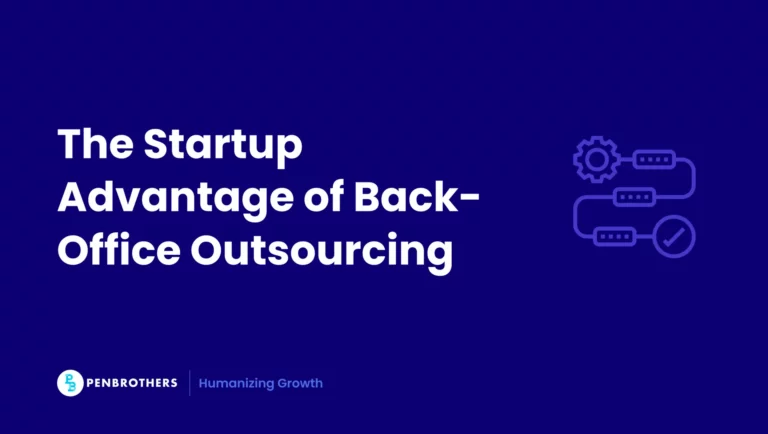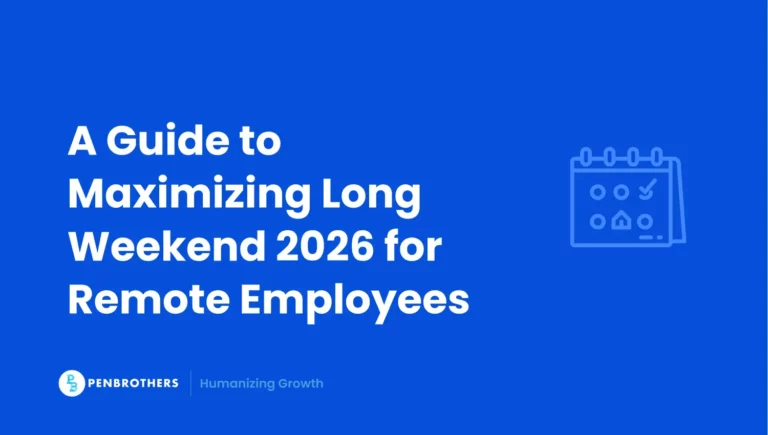The question of whether Filipinos are Hispanic often sparks debate due to the country’s complex and multifaceted history. To understand this, it’s important to explore the historical, cultural, and linguistic influences that shaped Filipino identity.
Key Takeaways
- Filipinos are Asian, Not Hispanic: While Filipinos have a deep historical connection to Spain due to over 300 years of colonization, they are ethnically and geographically Asian. Their primary genetic ancestry is Austronesian, and unlike in Hispanic countries, Spanish is not a widely spoken language.
- High English Proficiency Offers a Competitive Edge: The Philippines holds a significant advantage over many Latin American outsourcing hubs due to its workforce’s widespread, high-level English proficiency (ranked #22 globally). This makes Filipino talent particularly effective for customer-facing and complex back-office roles for Western clients.
- A Unique Work Culture Driven by “Bayanihan”: The Filipino work ethic is anchored in core values like “bayanihan” (community spirit) and “malasakit” (deep concern for the business). This translates into a highly collaborative, adaptable, and loyal workforce, with retention rates reaching 92% when supported by structured management.
- Spanish Surnames are a Colonial Legacy, Not Genetic: The prevalence of Spanish last names in the Philippines is primarily the result of a 1849 colonial administrative decree for tax and census purposes. For most Filipinos, these names represent a historical legacy rather than Spanish ancestry.
Historical Background: Spanish Colonization
Filipinos have a deep historical connection to Spain due to over 300 years of Spanish colonization from 1565 to 1898. During this period, the Philippines was governed as a Spanish colony, and many aspects of Filipino culture were heavily influenced by Spanish customs, traditions, and religion. The Spanish language, religion (predominantly Roman Catholicism), and various aspects of Filipino art, architecture, and cuisine were all shaped by this colonial rule.
As a result, many Filipino surnames and place names are of Spanish origin, and numerous customs still reflect Spanish traditions. For example, celebrations like Fiesta and Semana Santa (Holy Week) have strong Spanish roots. In addition, the Filipino practice of using terms like “Don” or “Doña” and the Spanish influence on family structures and societal hierarchy show the impact of Hispanic customs.
Cultural Differences: Filipino Identity Beyond Spanish Influence
Despite these deep cultural and historical connections, there are significant differences between Filipino and Hispanic identities.
Over time, the Philippines absorbed other foreign influences, notably from American, Chinese, and Indigenous cultures, which have also shaped Filipino identity.
- Language: While Spanish influenced Filipino languages, the official languages in the Philippines today are Tagalog (or Filipino) and English. Although some Spanish words remain in Filipino vocabulary, Spanish is not widely spoken in the Philippines. In contrast, Spanish is the primary language spoken in most Hispanic countries in Latin America and Spain.
- Race and Ethnicity: Filipinos are often seen as part of the Asian racial and ethnic group, whereas most Hispanic people identify as part of the Latino or Latin American community, which includes a wide range of ethnicities from indigenous to European descent. While there is some overlap in terms of cultural practices due to the colonial legacy, Filipinos are primarily considered Asian rather than Hispanic.
Thus, while Filipinos have a clear Hispanic influence in their history and culture, they are not considered Hispanic in the same way that Latin Americans or Spaniards are.
Comparing Work Culture: Filipinos vs. Hispanic Countries in Outsourcing
Now that we’ve addressed the question of whether Filipinos are Hispanic, let’s compare Filipino work culture to that of Hispanic countries, especially where outsourcing is common.
As global outsourcing continues to grow, both the Philippines and many Latin American countries are key players in providing services to businesses worldwide. While there are similarities in terms of cultural influences and work habits, Filipinos stand out in several key areas.
1. Work Ethic: Filipinos vs. Hispanics
Filipinos are renowned for their strong work ethic, anchored in ‘bayanihan’ (community spirit) and ‘malasakit’ (deep concern for the business). At Penbrothers, we channel this cultural trait into measurable results through our Hypercare Framework, a structured 180-day onboarding program designed to minimize early attrition. The result? A 92% retention rate after one year—significantly higher than the industry average. This proves that Filipino professionals don’t just fill seats; they commit to long-term career growth when supported by the right management structures. Many Filipinos are known to go above and beyond to meet deadlines and exceed expectations. This drive for excellence is often attributed to a deep sense of family loyalty and a commitment to providing for loved ones.
- Filipino workers are often described as having a “can-do” attitude, consistently showing initiative and resourcefulness in handling tasks.
- The Filipino work ethic is also characterized by a high level of adaptability. Filipinos can work in a variety of environments, handling different time zones, cultures, and languages with ease, which is especially beneficial in the context of outsourcing.
In comparison, work cultures in many Hispanic countries may emphasize collectivism and teamwork, but also often incorporate a more hierarchical structure. In some Latin American countries, workers may have a more formal attitude toward authority, which could impact decision-making or lead to a more top-down management approach.
2. Communication Skills: Filipinos vs. Hispanics
One of the most significant advantages of outsourcing for Filipino workers is their proficiency in English. As a former American colony, the Philippines adopted English as a second language, and it has become the country’s official language of government and business. Filipinos also have a high level of comfort with American-style communication, which is especially beneficial for U.S.-based clients.
Filipino workers excel in customer-facing roles such as call centers and technical support due to their clear, neutral English accent and effective communication style. Their ability to understand and adapt to Western business practices makes them a perfect fit for global companies.
Data support this competitive edge. In the 2024 EF English Proficiency Index, the Philippines ranked #22 globally, securing a ‘High Proficiency’ band. This significantly outperforms key outsourcing competitors in Latin America, such as Colombia (#74) and Mexico (#87), which both fell into the ‘Low’ and ‘Very Low’ proficiency bands, respectively. While Argentina (#28) remains a strong contender with high proficiency, the Philippines’ consistent top-tier ranking underscores its status as the premier destination for English-language voice and complex back-office support. This can pose a challenge for companies that need to communicate with clients in English, particularly in industries like customer service, where fluency in English is crucial.
3. Cultural Sensitivity: Filipinos vs. Hispanics
Filipinos are known for their cultural adaptability. Having been exposed to a wide range of cultural influences, including American, Spanish, and Asian, Filipinos are often praised for their ability to understand and blend into different cultural settings. In outsourcing, this translates to a high degree of cultural sensitivity and the ability to work seamlessly with clients from a wide array of countries.
Filipino workers, especially in the BPO sector, are trained to be customer-oriented and can handle interactions with clients from different backgrounds with tact and professionalism.
See how a customer service representative from the Philippines drives growth for an e-commerce platform here:
In contrast, while Hispanic workers are similarly known for being friendly and personable, the collectivist nature of many Hispanic cultures may sometimes lead to a preference for close-knit teams rather than working independently or with clients from outside their immediate culture. This can occasionally limit their adaptability in certain outsourcing contexts.
4. Cost Efficiency: Filipinos vs. Hispanics
Another reason the Philippines is often the preferred outsourcing destination is its cost efficiency. The Philippines offers highly skilled labor at a fraction of the cost compared to North America or Western Europe. This is due to the lower average wages in the Philippines compared to many Latin American countries.
In 2025, cost efficiency remains a primary driver. Industry reports project that outsourcing rates in the Philippines typically range from $6 to $20 per hour for skilled roles. In contrast, nearshore markets in Latin America often command higher premiums, with comparable roles in Mexico or Brazil ranging from $15 to $50 per hour. This 20-30% cost advantage allows growth-focused companies to scale teams faster—reinvesting the savings into technology, marketing, or additional headcount. This cost advantage allows businesses to scale more efficiently and save on operational expenses, making the Philippines an attractive option for companies looking to outsource.
If you’re looking for specific roles you need to fill, use this transparent employee calculator to easily compare salary costs.
5. Work-Life Balance: Filipinos vs. Hispanics
Work-life balance is an important factor for many workers, and in both the Philippines and many Hispanic countries, there is an emphasis on family and personal well-being. However, Filipinos are often known for their flexibility when it comes to balancing work with family life. They are willing to work long hours or adjust their schedules to meet the needs of international clients, especially when handling outsourcing roles that require them to work night shifts or irregular hours.
In many Hispanic countries, workers are also known for their strong family ties but may adhere more closely to traditional working hours. While flexibility is present, it may not always be as widely expected or practiced as it is in the Philippines.
Why Do Filipinos Have Spanish Names?
Walk through any Filipino neighborhood. You’ll meet families named Gonzalez, Rodriguez, Santos, and Cruz. Spanish surnames everywhere. Filipino first names, too: Maria, Jose, Carlos, Ana.
The names tell a colonial story, but not the one you might expect.
Spain didn’t just govern the Philippines for 300 years. It reorganized how Filipinos identified themselves. Before colonization, Filipinos used single names or descriptive titles tied to their communities. No family surnames as we understand them today.
Then came the Catalogo Alfabetico de Apellidos in 1849. Spain mandated that every Filipino family choose a surname from an official list. The Spanish colonial government wanted better record-keeping. Tax collection. Military conscription. Census data. You can’t efficiently govern people you can’t properly count and track.
Filipino families had to pick from thousands of Spanish surnames arranged alphabetically by region. Towns starting with “A” got surnames beginning with “A.” Towns with “B” got “B” surnames. This is why certain Spanish names cluster in specific Philippine regions even today.
But here’s what’s interesting: the names don’t indicate Spanish blood. They indicate Spanish administration. A Filipino family named “Delgado” might have zero Spanish ancestry. They simply lived in a town assigned surnames starting with “D” when the colonial bureaucrats came through.
Some families chose names honoring Spanish saints. Others picked surnames that sounded prestigious or carried social weight. Still others were simply assigned names by colonial officials who couldn’t pronounce their original Filipino names.
The practice stuck. Even after Spanish rule ended, Filipinos kept the surnames. They’d become part of identity, family heritage, and social structure. Changing them would have been like erasing generations of family history.
Today, Spanish surnames remain among the most common in the Philippines. But they represent administrative legacy, not genetic heritage. They’re artifacts of bureaucracy, not bloodline.
What Ethnicity Makes a Filipino?
Filipino ethnicity is layers upon layers. Like sediment in rock, each influence settled over the others without erasing what came before.
The foundation is Austronesian. Thousands of years ago, seafaring peoples from Taiwan migrated south through maritime Southeast Asia. They settled the Philippine archipelago, bringing languages, technologies, and cultures that still form the core of Filipino identity. This is the deepest layer.
Then came waves of trade and migration. Chinese merchants arrived early, intermarrying with local communities and establishing trading posts. Their influence shows up in Filipino cuisine, business practices, and family structures. Many Filipino families trace Chinese ancestry through surnames and traditions.
Islamic traders and missionaries brought Islam to the southern Philippines, particularly Mindanao and the Sulu archipelago. The Moro peoples developed distinct cultures blending Islamic traditions with indigenous practices.
Spanish colonization added another layer. Three centuries of rule introduced European genetic lines, primarily through Spanish soldiers, administrators, and religious orders who settled in the islands. But the numbers were relatively small. Spain governed the Philippines with far fewer colonists than other colonial powers used elsewhere.
American occupation from 1898 to 1946 brought limited additional European ancestry, along with American cultural influences that persist in education, government, and language.
The result? Modern Filipinos are predominantly Austronesian, with varying degrees of Chinese, Spanish, and other ancestries mixed in different proportions across different regions and families.
Genetic studies paint a precise picture of this biological history. According to the National Geographic Genographic Project, the average Filipino’s genetic makeup is approximately 53% Southeast Asian and Oceanian (Austronesian) and 36% East Asian. Interestingly, despite over three centuries of Spanish rule, Southern European ancestry averages only about 5%, with another 3% coming from South Asian sources. This data scientifically confirms that while the cultural footprint of Spain is massive, the genetic footprint is relatively minor compared to the indigenous Austronesian foundation. Others show more Spanish influence where colonial administration concentrated.
But percentages miss the point. Filipino ethnicity isn’t a math problem. It’s a cultural synthesis. The influences blended over centuries into something distinctly Filipino. Not Spanish, not Chinese, not purely Austronesian, but something new that emerged from all these layers.
This is why the Hispanic question gets complicated. Filipinos carry Spanish cultural influences and some Spanish ancestry. But they’re not Hispanic in the way Mexicans or Colombians are Hispanic. The foundation is different. The proportions are different. The historical experience created something unique.
Filipino ethnicity is Filipino. It doesn’t fit neatly into Hispanic, Asian, or any other single category. It’s its own thing, shaped by geography, history, and the particular way different peoples came together in this specific place over this specific time.
What is Filipino DNA Made Of?
If you look purely at DNA, the story is distinctly Asian. Comprehensive analysis by the Genographic Project reveals that the average Filipino genome is predominantly Southeast Asian and Oceanian (53%), reflecting the ancient Austronesian migrations.
The second largest component is East Asian (36%), evidence of centuries of pre-colonial trade with Chinese merchants. European markers (mostly Spanish) account for only about 5% of the average genome. This scientific breakdown clarifies a common confusion: Filipinos are culturally Hispanicized but genetically Asian.
Do Some Mexicans Have Filipino Ancestry?
Yes, and it’s a fascinating historical twist. During the Manila-Acapulco Galleon Trade (1565–1815), thousands of Filipino sailors (then called ‘Chinos Manila’) settled in Mexico, particularly in regions like Guerrero and Colima.
Recent genetic studies have found Asian ancestry markers in the modern population of Guerrero, Mexico, directly tracing back to these Filipino seafarers. While Filipinos adopted Spanish names and religion, they also left their own genetic and cultural mark in Mexico—introducing ‘tuba’ (coconut wine) and potentially influencing the ‘guayabera’ shirt.
What race is the Philippines considered?
In the United States, the Census Bureau classifies Filipinos under the ‘Asian’ racial category. However, the cultural reality is more complex.
Due to their unique history, many Filipinos identify with a ‘Third Space’—culturally bridging the East and West. While they check the ‘Asian’ box on forms, their lived experience shares deep parallels with Latino communities, including Roman Catholicism, Spanish loanwords, and close-knit family structures. This duality is exactly what makes Filipino talent so adaptable: they possess Asian discipline and industriousness mixed with Western cultural compatibility.
Why Filipinos Are Better for Outsourcing
While Hispanic countries certainly offer skilled workers and competitive outsourcing options, Filipino workers stand out in several key areas that make them more desirable for global outsourcing. Filipinos are not only highly proficient in English, but their work ethic, adaptability, and cultural sensitivity enable them to thrive in global business environments. Their cost-effectiveness, paired with a deep-seated customer service orientation, makes them ideal candidates for outsourcing roles in sectors like IT, customer support, data entry, and marketing.
In a world where businesses are increasingly looking for high-quality, reliable, and affordable outsourcing solutions, Filipinos have proven themselves to be exceptional partners who bring more than just technical skills—they bring a commitment to excellence, cultural flexibility, and a true understanding of global business needs.
How to Make Outsourcing Better for Your Business
At Penbrothers, we specialize in HR outsourcing solutions that are tailored to your unique needs, ensuring both client success and employee satisfaction. Here’s how we make outsourcing work for you:
Talent Quality
We take a personalized approach to recruitment, matching skilled professionals to your specific requirements. Our focus is on finding the right cultural fit, helping you maintain strong, high-performing teams even when outsourcing.
Comprehensive HR Services
We provide end-to-end HR support, covering recruitment, onboarding, payroll, and employee retention. Our full-service approach allows you to focus on your core business while we handle the administrative details and ensure compliance with local labor laws.
Global & Local Market Expertise
With deep knowledge of both local and international talent markets, especially in Southeast Asia, we connect you with skilled professionals at competitive rates, all without compromising on quality.
Compliance & Risk Mitigation
We navigate complex legal landscapes to ensure you stay fully compliant with labor laws, tax regulations, and other industry standards, minimizing the risks associated with outsourcing.
Ready to Transform Your Outsourcing Efforts?
At Penbrothers, we make outsourcing efficient, scalable, and risk-free by providing comprehensive HR solutions, securing top talent, and mitigating compliance risks. Partner with us today to streamline your outsourcing strategy and build a high-performing, compliant team. Let’s drive success together!
Frequently Asked Questions
No. Despite significant cultural influences from Spanish colonization, Filipinos are geographically and ethnically Asian. Their primary heritage is Austronesian, and Spanish is not a primary language in the Philippines.
Spanish surnames were mandated by a colonial decree in 1849 (the Catalogo Alfabetico de Apellidos) to organize tax collection and census records. Therefore, having a Spanish last name is typically a result of this administrative history, not evidence of Spanish blood.
The key advantages are superior English proficiency with a neutral accent, a highly adaptable and service-oriented work culture, significant cost efficiency (with lower labor costs for comparable skills), and a mature BPO industry infrastructure.
According to genetic studies, the average Filipino genome is approximately 53% Southeast Asian and Oceanian (Austronesian) and 36% East Asian. European ancestry accounts for only about 5%, confirming that the population is genetically distinct from Hispanic groups.
While both cultures value relationships and family, the Filipino work ethic is distinguished by a high degree of adaptability to different time zones and cultures and a strong sense of “malasakit” (concern for the business). This often leads to a “can-do” attitude and a willingness to go above and beyond for the team.






